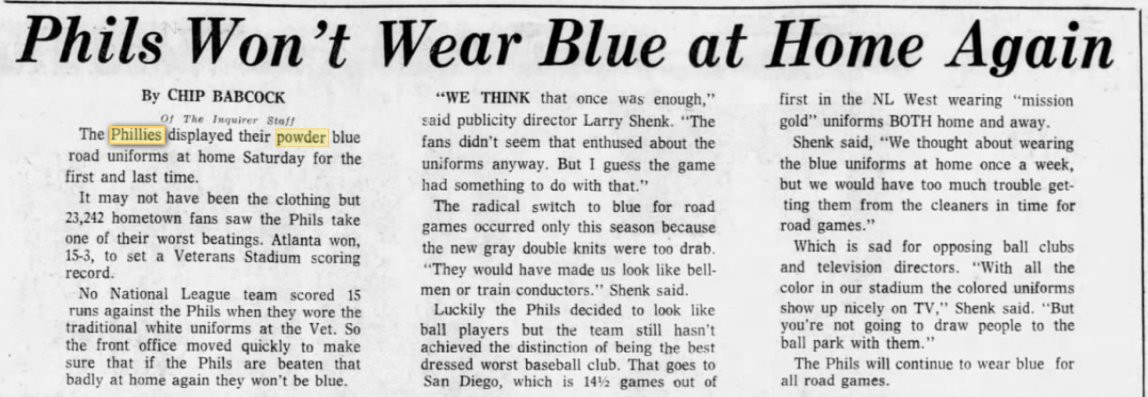Powder Blue Mlb Uniforms hold a special place in baseball history, evoking nostalgia for a vibrant era in the sport. While a tweet from DyNasty Fantasy pointed out the aesthetic appeal of the Phillies’ throwback powder blues, questioning the lack of matching base layers, the story of these uniforms is richer and more complex than a simple fashion statement.
 Phillies throwback uniforms with powder blue and white
Phillies throwback uniforms with powder blue and white
The Philadelphia Phillies donned their powder blue uniforms as throwbacks, sparking discussions about their historical significance. Interestingly, as Matt Breen, a Phillies beat writer, highlighted, the Phillies’ initial foray into powder blue at home was short-lived and not particularly successful. In 1972, for a single home game against the Braves, they sported powder blues, only to suffer a heavy 15-3 defeat. This experiment was promptly discontinued, suggesting that powder blue was initially conceived as a road uniform.
However, the allure of powder blue extends beyond just road games. Imagine if the Phillies had won that 1972 home game; perhaps powder blue MLB uniforms would have become a more common sight at home stadiums. This idea wasn’t entirely unfounded. The 1975 Texas Rangers, for instance, experimented with wearing their powder blue jerseys at home, albeit with a twist. They paired their blue road jerseys with their regular white home pants, a somewhat unconventional approach.
Delving deeper into the history of powder blue, it’s surprising to discover its origins predate the 1970s, the decade most often associated with this color. While the 70s saw powder blue uniforms gain significant traction, driven by the desire to move away from “drab” road grays and capitalize on the rise of color television, the first MLB team to embrace powder blue was actually the 1941 Chicago Cubs. They introduced a blue road vest, a style that, unfortunately, lasted only two seasons before they returned to gray.
The powder blue concept resurfaced in 1944 with the Brooklyn Dodgers. They experimented with a powder blue uniform made from satin fabric, a departure from the traditional wool flannel. Satin was chosen for its sheen and reflectivity, intended to enhance player visibility during night games. Although the satin experiment was short-lived, lasting only one season for the Dodgers, it was revived as a throwback in 2011, albeit not in satin and not exclusively for night games.
The modern powder blue era began to take shape in 1969 with the arrival of two expansion teams: the Seattle Pilots and the Montreal Expos. Both teams adopted powder blue for their inaugural road uniforms. However, with MLB uniforms still being made from flannel at the time, the blue shades lacked the vibrancy that would later become characteristic of powder blue when rendered in polyester.
The true breakthrough for powder blue came in the early 1970s with the widespread adoption of polyester stretch-knit fabrics by MLB teams. Polyester allowed for much richer, more saturated colors, and powder blue truly “popped” in this new material. A pivotal moment arrived in 1972 when both the American League MVP, Dick Allen of the White Sox, and the National League Cy Young Award winner, Steve Carlton of the Phillies, played for teams sporting powder blue road uniforms. This marked the first time players from blue-clad teams had won either award, lending significant credibility and prestige to the powder blue style.
Powder blue’s popularity surged throughout the 1970s, reaching its zenith in 1980 and 1981 when a remarkable 11 MLB teams sported blue road uniforms. The 1980 World Series between the Phillies and the Royals was a historic event, marking the first time two powder blue-clad teams faced off in the Fall Classic.
However, the tide began to turn in the late 1980s. MLB teams gradually moved away from the uniform trends of the preceding decade, including pullover jerseys, elastic waistbands, and the vibrant “Technicolor” palettes, which included powder blue. By 1991, only two powder blue holdouts remained: the Expos and the Royals. In 1992, they too transitioned to road gray, seemingly bringing the powder blue era to an end.
Yet, powder blue MLB uniforms didn’t vanish entirely. Their disappearance sparked nostalgia, leading to their revival as throwback uniforms. While the fit and styling might look different on today’s players with their baggier tailoring and longer pants, the nostalgic charm of powder blue remains undeniable.
Today, powder blue is embraced as a throwback or alternate uniform, offering a welcome splash of color and a nod to baseball’s vibrant past. While no team has yet dared to reinstate powder blue as their primary road uniform, for teams like the Royals, Blue Jays, or Phillies, powder blue is deeply embedded in their identity. Perhaps it’s time for a team to take the plunge and bring powder blue back to the forefront, not just as a nostalgic nod, but as a primary color in their on-field presentation.
